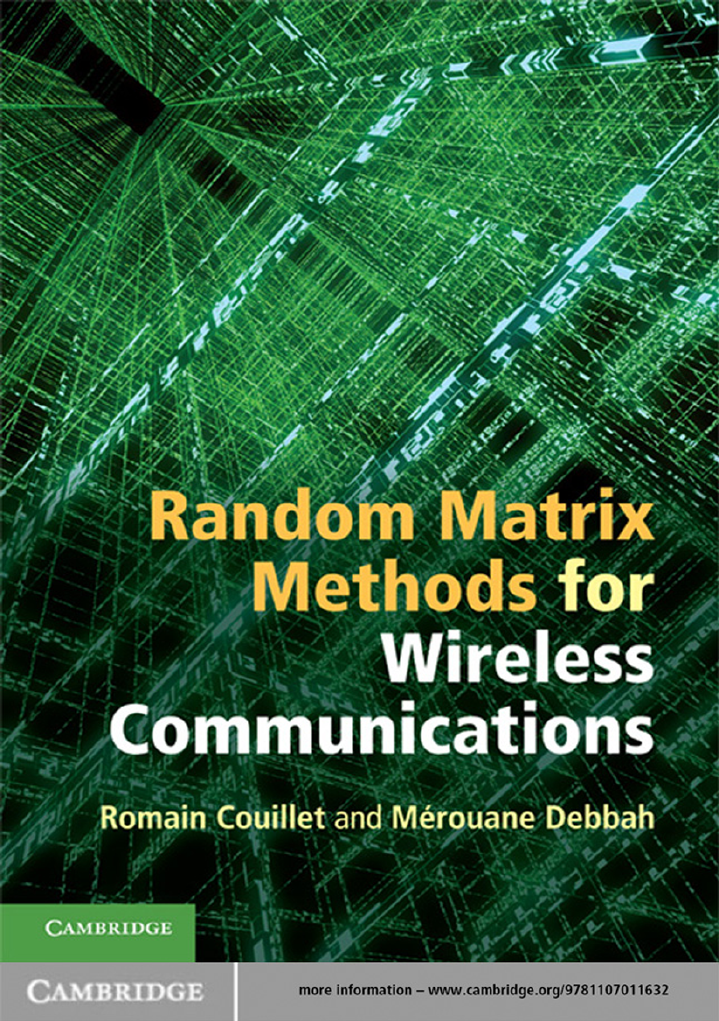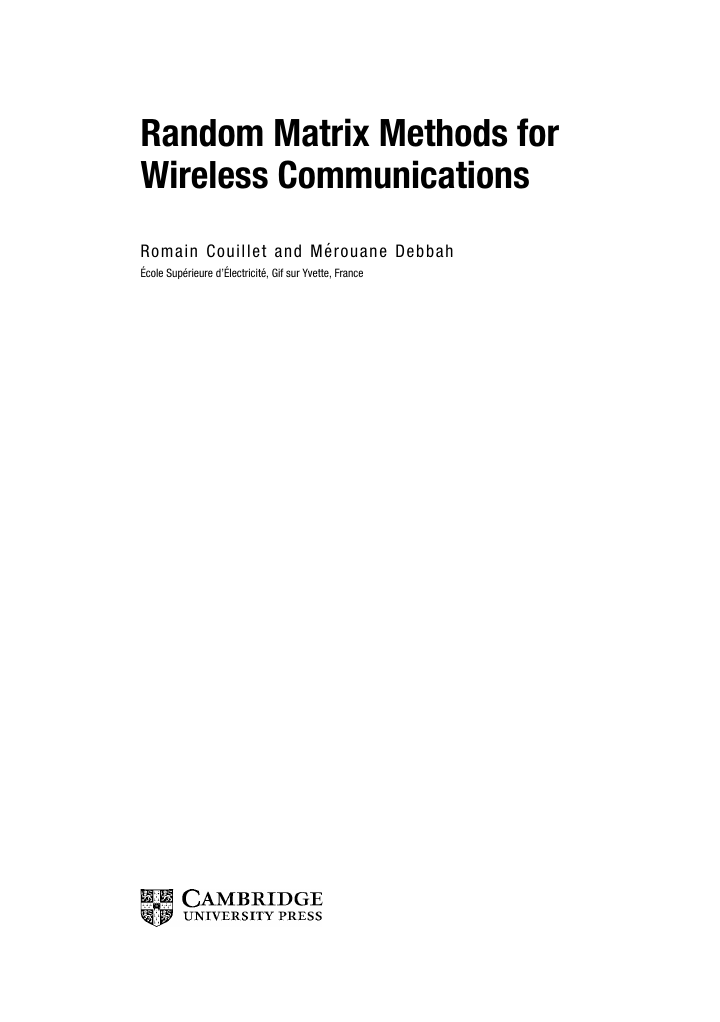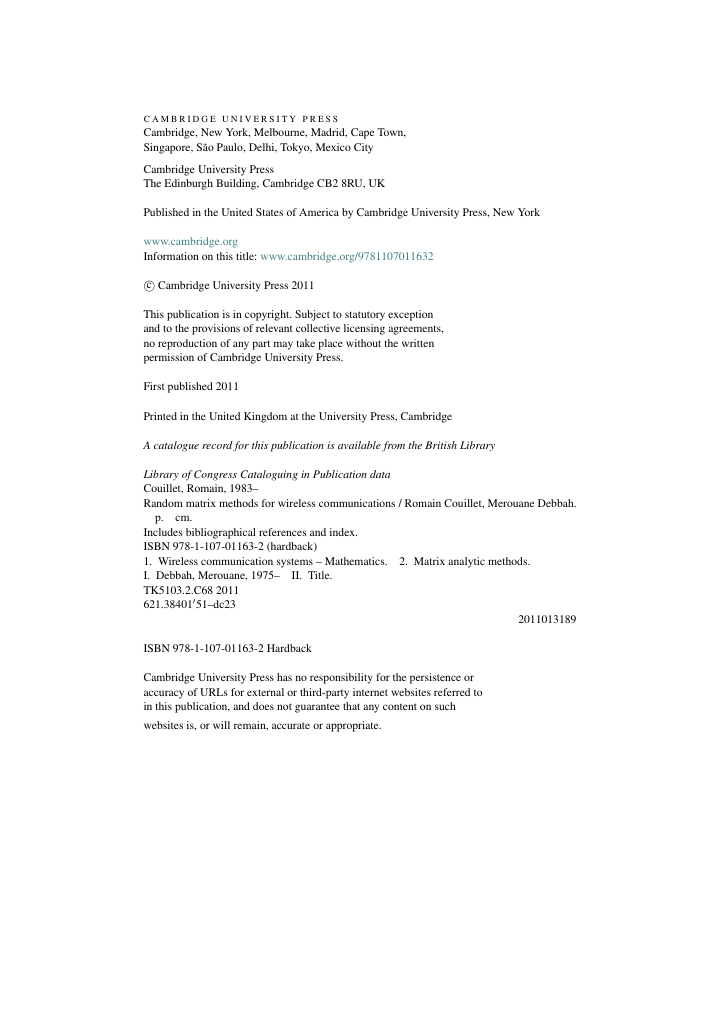Cover
Title
Copyright
Dedication
Contents
Preface
Acknowledgments
Acronyms
Notation
1 Introduction
1.1 Motivation
1.2 History and book outline
Part I Theoretical aspects
2 Random matrices
2.1 Small dimensional random matrices
2.1.1 Definitions and notations
2.1.2 Wishart matrices
2.2 Large dimensional random matrices
2.2.1 Why go to infinity?
2.2.2 Limit spectral distributions
3 The Stieltjes transform method
3.1 Definitions and overview
3.2 The MarĊenko–Pastur law
3.2.1 Proof of the MarĊenko–Pastur law
3.2.2 Truncation, centralization, and rescaling
3.3 Stieltjes transform for advanced models
3.4 Tonelli theorem
3.5 Central limit theorems
4 Free probability theory
4.1 Introduction to free probability theory
4.2 R- and S-transforms
4.3 Free probability and random matrices
4.4 Free probability for Gaussian matrices
4.5 Free probability for Haar matrices
5 Combinatoric approaches
5.1 The method of moments
5.2 Free moments and cumulants
5.3 Generalization to more structured matrices
5.4 Free moments in small dimensional matrices
5.5 Rectangular free probability
5.6 Methodology
6 Deterministic equivalents
6.1 Introduction to deterministic equivalents
6.2 Techniques for deterministic equivalents
6.2.1 Bai and Silverstein method
6.2.2 Gaussian method
6.2.3 Information plus noise models
6.2.4 Models involving Haar matrices
6.3 A central limit theorem
7 Spectrum analysis
7.1 Sample covariance matrix
7.1.1 No eigenvalues outside the support
7.1.2 Exact spectrum separation
7.1.3 Asymptotic spectrum analysis
7.2 Information plus noise model
7.2.1 Exact separation
7.2.2 Asymptotic spectrum analysis
8 Eigen-inference
8.1 G-estimation
8.1.1 Girko G-estimators
8.1.2 G-estimation of population eigenvalues and eigenvectors
8.1.3 Central limit for G-estimators
8.2 Moment deconvolution approach
9 Extreme eigenvalues
9.1 Spiked models
9.1.1 Perturbed sample covariance matrix
9.1.2 Perturbed random matrices with invariance properties
9.2 Distribution of extreme eigenvalues
9.2.1 Introduction to the method of orthogonal polynomials
9.2.2 Limiting laws of the extreme eigenvalues
9.3 Random matrix theory and eigenvectors
10 Summary and partial conclusions
Part II Applications to wireless communications
11 Introduction to applications in telecommunications
11.1 Historical account of major results
11.1.1 Rate performance of multi-dimensional systems
11.1.2 Detection and estimation in large dimensional systems
11.1.3 Random matrices and flexible radio
12 System performance of CDMA technologies
12.1 Introduction
12.2 Performance of random CDMA technologies
12.2.1 Random CDMA in uplink frequency flat channels
12.2.2 Random CDMA in uplink frequency selective channels
12.2.3 Random CDMA in downlink frequency selective channels
12.3 Performance of orthogonal CDMA technologies
12.3.1 Orthogonal CDMA in uplink frequency flat channels
12.3.2 Orthogonal CDMA in uplink frequency selective channels
12.3.2.1 Matched-flter
12.3.3 Orthogonal CDMA in downlink frequency selective channels
12.3.3.1 Matched-flter
12.3.3.2 MMSE decoder
13 Performance of multiple antenna systems
13.1 Quasi-static MIMO fading channels
13.2 Time-varying Rayleigh channels
13.2.1 Small dimensional analysis
13.2.2 Large dimensional analysis
13.2.3 Outage capacity
13.3 Correlated frequency flat fading channels
13.3.1 Communication in strongly correlated channels
13.3.2 Ergodic capacity in strongly correlated channels
13.3.3 Ergodic capacity in weakly correlated channels
13.3.4 Capacity maximizing precoder
13.4 Rician flat fading channels
13.4.1 Quasi-static mutual information and ergodic capacity
13.4.2 Capacity maximizing power allocation
13.4.3 Outage mutual information
13.5 Frequency selective channels
13.5.1 Ergodic capacity
13.5.2 Capacity maximizing power allocation
13.6 Transceiver design
13.6.1 Channel matrix model with i.i.d. entries
13.6.2 Channel matrix model with generalized variance profile
14 Rate performance in multiple access and broadcast channels
14.1 Broadcast channels with linear precoders
14.1.1 System model
14.1.2 Deterministic equivalent of the SINR
14.1.3 Optimal regularized zero-forcing precoding
14.1.4 Zero-forcing precoding
14.1.5 Applications
14.2 Rate region of MIMO multiple access channels
14.2.1 MAC rate region in quasi-static channels
14.2.2 Ergodic MAC rate region
14.2.3 Multi-user uplink sum rate capacity
15 Performance of multi-cellular and relay networks
15.1 Performance of multi-cell networks
15.1.1 Two-cell network
15.1.2 Wyner model
15.2 Multi-hop communications
15.2.1 Multi-hop model
15.2.2 Mutual information
15.2.3 Large dimensional analysis
15.2.4 Optimal transmission strategy
16 Detection
16.1 Cognitive radios and sensor networks
16.2 System model
16.3 Neyman–Pearson criterion
16.3.1 Known signal and noise variances
16.3.1.1 Derivation of PY│Hi in the SIMO case
16.3.1.2 Multi-source case
16.3.2 Unknown signal and noise variances
16.3.3 Unknown number of sources
16.4 Alternative signal sensing approaches
16.4.1 Condition number method
16.4.2 Generalized likelihood ratio test
16.4.3 Test power and error exponents
17 Estimation
17.1 Directions of arrival
17.1.1 System model
17.1.2 The MUSIC approach
17.1.3 Large dimensional eigen-inference
17.1.4 The correlated signal case
17.2 Blind multi-source localization
17.2.1 System model
17.2.2 Small dimensional inference
17.2.3 Conventional large dimensional approach
17.2.4 Free deconvolution approach
17.2.5 Analytic method
17.2.6 Joint estimation of number of users, antennas and powers
17.2.7 Performance analysis
17.2.7.1 Method comparison
17.2.7.2 Joint estimation of K, nk, Pk
18 System modeling
18.1 Introduction to Bayesian channel modeling
18.2 Channel modeling under environmental uncertainty
18.2.1 Channel energy constraints
18.2.1.1 Average channel energy constraint
18.2.1.2 Probabilistic average channel energy constraint
18.2.1.3 Application to the single antenna channel
18.2.2 Spatial correlation models
18.2.2.1 Deterministic knowledge of the correlation matrix
18.2.2.2 Knowledge of the existence of a correlation matrix
18.2.2.3 Limited-rank covariance matrix
18.2.2.4 Discussion
19 Perspectives
19.1 From asymptotic results to finite dimensional studies
19.2 The replica method
19.3 Towards time-varying random matrices
20 Conclusion
References
Index
















 2023年江西萍乡中考道德与法治真题及答案.doc
2023年江西萍乡中考道德与法治真题及答案.doc 2012年重庆南川中考生物真题及答案.doc
2012年重庆南川中考生物真题及答案.doc 2013年江西师范大学地理学综合及文艺理论基础考研真题.doc
2013年江西师范大学地理学综合及文艺理论基础考研真题.doc 2020年四川甘孜小升初语文真题及答案I卷.doc
2020年四川甘孜小升初语文真题及答案I卷.doc 2020年注册岩土工程师专业基础考试真题及答案.doc
2020年注册岩土工程师专业基础考试真题及答案.doc 2023-2024学年福建省厦门市九年级上学期数学月考试题及答案.doc
2023-2024学年福建省厦门市九年级上学期数学月考试题及答案.doc 2021-2022学年辽宁省沈阳市大东区九年级上学期语文期末试题及答案.doc
2021-2022学年辽宁省沈阳市大东区九年级上学期语文期末试题及答案.doc 2022-2023学年北京东城区初三第一学期物理期末试卷及答案.doc
2022-2023学年北京东城区初三第一学期物理期末试卷及答案.doc 2018上半年江西教师资格初中地理学科知识与教学能力真题及答案.doc
2018上半年江西教师资格初中地理学科知识与教学能力真题及答案.doc 2012年河北国家公务员申论考试真题及答案-省级.doc
2012年河北国家公务员申论考试真题及答案-省级.doc 2020-2021学年江苏省扬州市江都区邵樊片九年级上学期数学第一次质量检测试题及答案.doc
2020-2021学年江苏省扬州市江都区邵樊片九年级上学期数学第一次质量检测试题及答案.doc 2022下半年黑龙江教师资格证中学综合素质真题及答案.doc
2022下半年黑龙江教师资格证中学综合素质真题及答案.doc